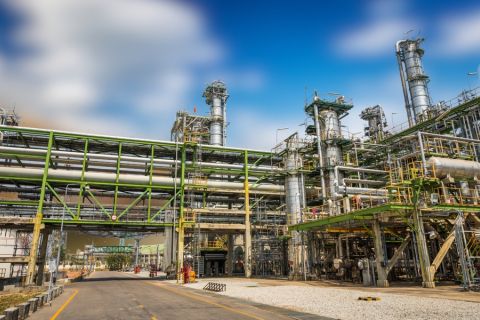Anyone who follows seismic acquisition is probably aware of the vast strides made in the marine environment in just a few short years—wide-azimuth surveys, broadband technology and node acquisition, to name a few.
On land it’s mostly been about brute strength.
Land acquisition is kind of the ugly stepchild of marine seismic. Instead of towing streamers behind a boat on vast unobstructed tracts of ocean, land acquisition encounters issues with topography and cultural obstacles such as roads and towns. Some areas are so challenging topographically (or environmentally) that vibrator trucks, the standard source mechanism for land acquisition, are unable to access the area, and dynamite must be used. And after all of this additional hassle, land data are never quite as good as marine data due to ground roll effects, shot-generated backscatter, and seasonal and water table changes.
These issues are particularly significant in the Middle East, where a complex near surface tends to obscure the relatively low-relief structures beneath. Over the past few years Saudi Aramco has sought to overcome this problem by experimenting with sampling density, and that discussion is the topic of this year’s Society of Exploration Geophysicists’ Distinguished Lecture, being given by Peter I. Pecholcs.
An uncooperative environment
In his abstract, Pecholcs describes the near-surface environment as formed by the dissolution of carbonate and anhydrite, or karst, formations. “This dissolution process formed a complex network of open and collapsed caverns that act as secondary scatterers that mask the primary reflections during seismic acquisition,” he noted. “Under these conditions, when only 240-channel recording systems were available, it was routine to use a 72-geophone array (six by 12 geophones/string) laid out over an area 108 m by 50 m [354 ft by 164 ft] along with five vibrators per fleet, sweeping simultaneously with a 10-m [33-ft] move-up. Yes, it was a sea of geophones.”
Early failed attempt
Technology would soon change, however. In 2001 the company upgraded a 480-channel 2-D crew to 2,880 channels using individual geophone strings and single sweeps instead of infield receiver and source arrays. The group interval was reduced from 25 m to 5 m (82 ft to 16.4 ft). The hope was to attain a higher resolution subsurface image. But the results were disappointing.
During his talk, Pecholcs showed an image from this survey after one year of processing. The data were scrappy at best.
“I was the proponent—I was the guy pushing for source density, receiver density and sampling density,” he said. “I thought I was going to lose my job.”
He and his team were faced with numerous questions. “It was unclear why we could not extend the high-frequency limit beyond 40 or 60 Hz at best,” Pecholcs wrote in his abstract. “Was the signal buried in a broadband backscattered noise floor?”
Over the next few years the group took advantage of increasing recording channel count to improve spatial sampling grids using longer offsets and wider azimuths. “If you want to do full-azimuth [FAZ] survey designs and you do a single azimuth, you may be unlucky enough to pick the wrong azimuth,” he said. He compared the original image with an FAZ acquisition image, brute-stack with post-stack migration. Even the near-surface area showed superior resolution to the original 2-D line. Prior to full processing, the signal to noise (S/N) ratio was vastly improved, he noted.
By 2010, he wrote, “We experienced a seismic revolution in channel capacity.” Saudi Aramco was using 25,000 active channels for two production crews and 100,000 channels for one pilot crew, regularly producing several terabytes of data per day. One project, Pecholcs noted, produced one petabyte of raw source records covering 1,700 sq km (656 sq miles). Hardware and software had to be modified to manage these large datasets, and new workflows were developed for traces with low S/N ratios.
“The formation of an integrated team with efficient transverse communication procedures was the key to creative and innovative solutions,” he wrote. “The high-resolution time and impedance images, attribute maps, and extracted geobodies brought us one step closer to the engineers.”
More to come
In Pecholcs’ view, sampling is everything. He said that during the time he and his Saudi Aramco team were seeking to improve spatial sampling, the question came up: How much fold is enough? The answer always seemed to be, “It is not enough,” regardless of the sampling density.
To gain the needed improvements, his team experimented not only with receiver density but with source density as well. By using five vibrator trucks and shooting 400 vibrator points per square kilometer (.38 sq mile), the S/N ratio was improved.
The next test was a 32,000-channel survey design. The results with 100-m (328-ft) receiver and line intervals were good. “So I said, ‘OK, let’s cheat,’” he said. “Let’s use the best parameters from this and just decimate the line intervals and see what happens. When we did that, we found out that the line interval also played a very important part in S/N ratio.”
In relatively flat areas like those in the Middle East, it’s possible to shoot what Pecholcs refers to as a “carpet” of shots, increasing the source density and using high-productivity methods to create a good FAZ design.
Ultimately, improving the sampling density can improve the quality of land seismic data to be almost comparable to marine data. Pecholcs showed images comparing conventional land to conventional marine data and also broadband land and broadband marine. “I would argue that land is getting pretty close to marine if you’re lucky to get the sampling density that’s required,” he said.
As the industry continues to make strides in land acquisition technology, seismic processing methodology is struggling to keep up. One improvement Pecholcs would like to see is a move from using acoustic wave algorithms to elastic wave algorithms. “We record in an elastic wavefield; we don’t record acoustic wavefields,” he said.
And sampling density will continue to increase. “There is one company that has announced that it will be able to record 1 million channels,” he said. “Who can pay for 1 million channels is a whole different story.”
Recommended Reading
Marketed: Bendel Ventures 73 Well Package in Texas
2024-03-05 - Bendel Ventures LP has retained EnergyNet for the sale of a 73 well package in Iron and Reagan counties, Texas.
Marketed: EnCore Permian Holdings 17 Asset Packages
2024-03-05 - EnCore Permian Holdings LP has retained EnergyNet for the sale of 17 asset packages available on EnergyNet's platform.
CERAWeek: Exxon Mobil CEO Says Not Trying to Acquire Hess
2024-03-18 - CEO Darren Woods said Exxon Mobil is trying to secure preemption rights over Hess Corp.'s Guyana assets in its dispute with Chevron, not buy the company itself.
Oilfield Service Companies Dril-Quip, Innovex to Merge
2024-03-18 - Dril-Quip Inc. and Innovex Downhole Solutions Inc. will emerge as a new company, Innovex International, with expanded reach in global markets.
Talos Energy Sells CCS Business to TotalEnergies
2024-03-18 - TotalEnergies’ acquisition targets Talos Energy’s Bayou Bend project, and the French company plans to sell off the remainder of Talos’ carbon capture and sequestration portfolio in Texas and Louisiana.


